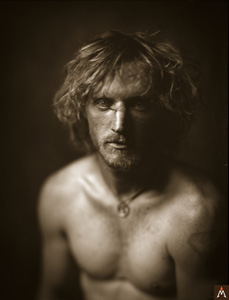Top row, L to R: Chamonix whole plate view camera, Quinn Jacobson Studio Q
Bottom row: Three test images using this camera
John and Coleen tried and tried to make their digital images look like Edward Curtis’. They tried a tilt/shift lens, a digital Petzval lens, played with extreme shallow depth of field, and even with the Photoshop mastery skills that they both have, they just could not achieve the desired results they wanted for the Descendants Project.
Soooooo what did you try next? Well, they found the answer is as simple as doing it as Curtis did it. You get a new Chamonix View Camera that uses 6.5×8.5” glass plate negatives! John and Coleen couldn’t find a working Rochester Reversible Back camera (said to be Curtis’ favorite camera and size format), so the Chamonix was the current brand chosen for their project.
Then they found a Miller Petzval 355mm f 5.6 lens that dates back to the 1860s, thanks to their friend Quinn Jacobson, world renown large format photographer and historical printing process expert. Then they acquired a Wollensak Optical Co. Rapid Rectilinear normal to slightly wide angle lens circa late 1800s as well.
The last secret to the mysterious equation is the use of glass plates instead of film and dry processing them, again just as Curtis did.
Now to test, experiment and practice! And as all good portrait photographers, Coleen forced her children and grandson to pose for them. “Do this or you get no dinner”, still works!










